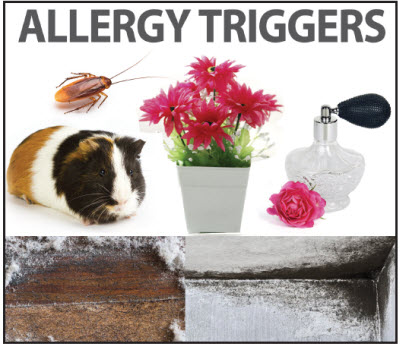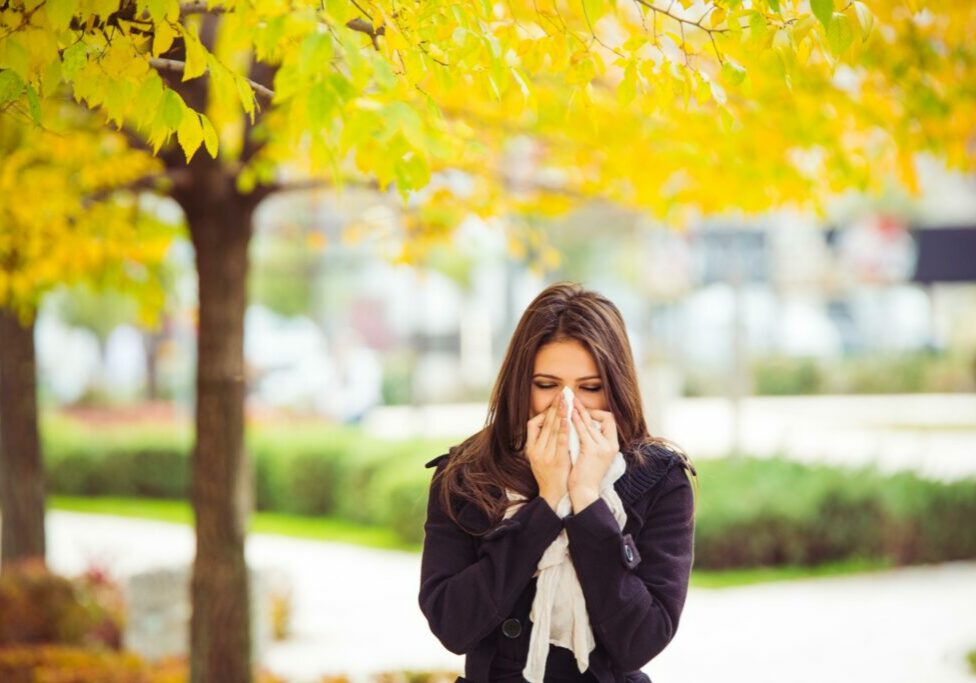Poor indoor air quality is associated with many symptoms, including headache, fatigue, nausea, dry throat, itchy eyes, stuffy or runny nose, skin rashes and loss of concentration. Poor indoor air quality can also trigger an allergy or asthma episode, if trigger substances are present (see below). About 10 percent of New Jersey school children suffer from asthma, and rates may be as high as 30 percent in inner cities. About 20 percent of Americans suffer from allergies.
 What are allergies and asthma?
What are allergies and asthma?
Allergies are immune over-responses to certain substances that are not harmful to non-allergic people. The immune response leads to symptoms of congestion; sneezing; and itchy eyes, ears, nose, and throat.
Asthma is similar, but affects the airways. People with asthma have airways that are especially sensitive to triggers, including allergens such as pollen and pets, and irritants, such as smoke and fragrances. The immune system overreacts and causes airways to narrow in three ways: inflammation, excess mucous, and constriction of muscles around the airways. The resulting reduced air flow can lead to typical asthma symptoms of chest tightness, difficulty breathing, wheezing, and coughing.
Asthma triggers are different for each sufferer, and in addition to allergens and irritants may include, temperature extremes, high humidity, foods, stress, and exercise. Since allergens and irritants are triggers for allergy sufferers as well as asthmatics, it is important for schools to identify and reduce them in building air.
What local associations can do
Local associations can survey staff about symptoms and triggers. With that information a building map can be created to prioritize areas needing attention. This is a good task for the local Health and Safety Committee. The local association can support teachers and other staff in making their classrooms or other work areas trigger free. The local association should also work with its UniServ field rep to push for necessary actions to address identified triggers that require broader action.
A comprehensive approach for addressing asthma that includes both trigger control and asthma management in schools is offered by the School Task Force of the Pediatric Asthma Coalition of New Jersey (PACNJ). Among other provisions, the program includes:
- Training for nurses (required by the state’s asthma law, NJSA 18A:40).
- Training for teachers on trigger control and responding to a student episode (required by the same law).
- Training for school maintenance staff and district staff on trigger control in buildings.
Participating schools that fulfill a list of PACNJ requirements can win an Asthma Friendly School
Award. About 16 percent of New Jersey schools currently have the award.
Staff can control some triggers in classrooms and other work areas
- Dust mites: These are small insects whose droppings may trigger allergies and asthma. They are found in fabric and dust. If possible, have no upholstered furniture or carpets. If you cannot get rid of them, vacuum them with a HEPA (high efficiency particulate air filter) vacuum. Stuffed animals and rugs should be periodically washed in very hot water to kill mites. Surface dust should be damp-wiped or damp-mopped. Minimize knick knacks that collect dust.
- Cleaners: Use non-allergenic classroom cleaners that are liquid, not aerosols.
- Markers and art supplies: Use low-emissions non-toxic markers and art supplies.
- Pets: Avoid pets with fur or feathers if you or your students have allergies or asthma.
- Pollen: If room occupants are allergic to pollen, keep windows closed if possible in spring and fall. Ideally provide filtered fresh air.
- Ventilation: Make sure classroom univents are kept clean and unobstructed.
Other triggers require a broader effort
- Mold: Wet building materials must be replaced, sources of water incursion eliminated, and any mold present cleaned up. Often a fix requires extensive repairs and renovations.
- Rodents and cockroaches: Droppings and body parts of rodents and roaches are allergens and asthma triggers. All trash and food waste should be disposed of properly. Fill cracks and clean and dry any place where pests can nest or hide.
- Chemicals: Choose cleaning products, maintenance chemicals (such as floor wax and solvents) and pest control products that have low toxicity. Avoid sprays in favor of liquid products. Products with strong odors should be used after school hours only and with ventilation.
- Vehicle emissions. Ensure enforcement of New Jersey’s law prohibiting buses idling outside the building (NJAC 7:27-14). When fork lifts or other vehicles powered by fossil fuels are used indoors, ensure that exhaust is channeled outside the building. Replace them with electric vehicles.
- Ventilation system. Ensure that the heating, ventilation, and air-conditioning (HVAC) system is maintained, including changing filters on a regular basis (required by NJAC 12:100-13). Classroom univents should be maintained and kept clean and unobstructed.
